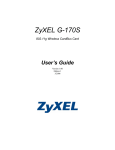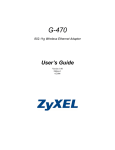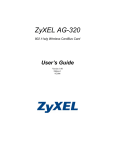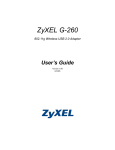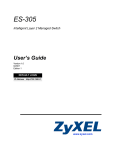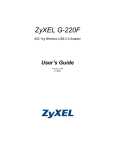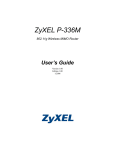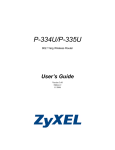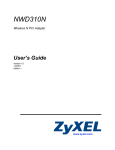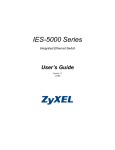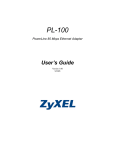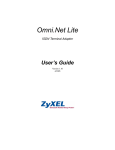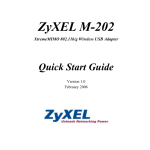Download ZyXEL M-302 User's Manual
Transcript
M-302 802.11g Wireless MIMO PCI card User’s Guide Version 2.00 Edition 1 4/2006 M-302 User’s Guide Copyright Copyright © 2006 by ZyXEL Communications Corporation. The contents of this publication may not be reproduced in any part or as a whole, transcribed, stored in a retrieval system, translated into any language, or transmitted in any form or by any means, electronic, mechanical, magnetic, optical, chemical, photocopying, manual, or otherwise, without the prior written permission of ZyXEL Communications Corporation. Published by ZyXEL Communications Corporation. All rights reserved. Disclaimer ZyXEL does not assume any liability arising out of the application or use of any products, or software described herein. Neither does it convey any license under its patent rights nor the patent rights of others. ZyXEL further reserves the right to make changes in any products described herein without notice. This publication is subject to change without notice. Trademarks ZyNOS (ZyXEL Network Operating System) is a registered trademark of ZyXEL Communications, Inc. Other trademarks mentioned in this publication are used for identification purposes only and may be properties of their respective owners. Copyright 3 M-302 User’s Guide Certifications Federal Communications Commission (FCC) Interference Statement This device complies with Part 15 of FCC rules. Operation is subject to the following two conditions: • This device may not cause harmful interference. • This device must accept any interference received, including interference that may cause undesired operations. This equipment has been tested and found to comply with the limits for a Class B digital device pursuant to Part 15 of the FCC Rules. These limits are designed to provide reasonable protection against harmful interference in a commercial environment. This equipment generates, uses, and can radiate radio frequency energy, and if not installed and used in accordance with the instructions, may cause harmful interference to radio communications. If this equipment does cause harmful interference to radio/television reception, which can be determined by turning the equipment off and on, the user is encouraged to try to correct the interference by one or more of the following measures: • Reorient or relocate the receiving antenna. • Increase the separation between the equipment and the receiver. • Connect the equipment into an outlet on a circuit different from that to which the receiver is connected. • Consult the dealer or an experienced radio/TV technician for help. Notice 1 Changes or modifications not expressly approved by the party responsible for compliance could void the user's authority to operate the equipment. This Class B digital apparatus complies with Canadian ICES-003. Cet appareil numérique de la classe B est conforme à la norme NMB-003 du Canada. Viewing Certifications 1 Go to http://www.zyxel.com. 2 Select your product from the drop-down list box on the ZyXEL home page to go to that product's page. 3 Select the certification you wish to view from this page. 4 Certifications M-302 User’s Guide Certifications 5 M-302 User’s Guide Safety Warnings For your safety, be sure to read and follow all warning notices and instructions. • Do NOT open the device or unit. Opening or removing covers can expose you to dangerous high voltage points or other risks. ONLY qualified service personnel can service the device. Please contact your vendor for further information. • Connect the power cord to the right supply voltage (110V AC in North America or 230V AC in Europe). • Place connecting cables carefully so that no one will step on them or stumble over them. Do NOT allow anything to rest on the power cord and do NOT locate the product where anyone can walk on the power cord. • If you wall mount your device, make sure that no electrical, gas or water pipes will be damaged. • Do NOT install nor use your device during a thunderstorm. There may be a remote risk of electric shock from lightning. • Do NOT expose your device to dampness, dust or corrosive liquids. • Do NOT use this product near water, for example, in a wet basement or near a swimming pool. • Make sure to connect the cables to the correct ports. • Do NOT obstruct the device ventilation slots, as insufficient airflow may harm your device. • Do NOT store things on the device. • Connect ONLY suitable accessories to the device. 6 Safety Warnings M-302 User’s Guide ZyXEL Limited Warranty ZyXEL warrants to the original end user (purchaser) that this product is free from any defects in materials or workmanship for a period of up to two years from the date of purchase. During the warranty period, and upon proof of purchase, should the product have indications of failure due to faulty workmanship and/or materials, ZyXEL will, at its discretion, repair or replace the defective products or components without charge for either parts or labor, and to whatever extent it shall deem necessary to restore the product or components to proper operating condition. Any replacement will consist of a new or re-manufactured functionally equivalent product of equal value, and will be solely at the discretion of ZyXEL. This warranty shall not apply if the product is modified, misused, tampered with, damaged by an act of God, or subjected to abnormal working conditions. Note Repair or replacement, as provided under this warranty, is the exclusive remedy of the purchaser. This warranty is in lieu of all other warranties, express or implied, including any implied warranty of merchantability or fitness for a particular use or purpose. ZyXEL shall in no event be held liable for indirect or consequential damages of any kind of character to the purchaser. To obtain the services of this warranty, contact ZyXEL's Service Center for your Return Material Authorization number (RMA). Products must be returned Postage Prepaid. It is recommended that the unit be insured when shipped. Any returned products without proof of purchase or those with an out-dated warranty will be repaired or replaced (at the discretion of ZyXEL) and the customer will be billed for parts and labor. All repaired or replaced products will be shipped by ZyXEL to the corresponding return address, Postage Paid. This warranty gives you specific legal rights, and you may also have other rights that vary from country to country. ZyXEL Limited Warranty 7 M-302 User’s Guide Customer Support Please have the following information ready when you contact customer support. • • • • Product model and serial number. Warranty Information. Date that you received your device. Brief description of the problem and the steps you took to solve it. METHOD SUPPORT E-MAIL TELEPHONEA WEB SITE FAX FTP SITE REGULAR MAIL LOCATION CORPORATE HEADQUARTERS (WORLDWIDE) CZECH REPUBLIC DENMARK FINLAND SALES E-MAIL [email protected] +886-3-578-3942 [email protected] [email protected] +420-241-091-350 [email protected] +420-241-091-359 [email protected] +45-39-55-07-00 [email protected] +45-39-55-07-07 [email protected] +358-9-4780-8411 [email protected] +358-9-4780 8448 [email protected] +33-4-72-52-97-97 HUNGARY KAZAKHSTAN 8 ZyXEL Communications Czech s.r.o. Modranská 621 143 01 Praha 4 - Modrany Ceská Republika www.zyxel.dk ZyXEL Communications A/S Columbusvej 2860 Soeborg Denmark www.zyxel.fi ZyXEL Communications Oy Malminkaari 10 00700 Helsinki Finland www.zyxel.fr ZyXEL France 1 rue des Vergers Bat. 1 / C 69760 Limonest France www.zyxel.de ZyXEL Deutschland GmbH. Adenauerstr. 20/A2 D-52146 Wuerselen Germany www.zyxel.hu ZyXEL Hungary 48, Zoldlomb Str. H-1025, Budapest Hungary www.zyxel.kz ZyXEL Kazakhstan 43, Dostyk ave.,Office 414 Dostyk Business Centre 050010, Almaty Republic of Kazakhstan ZyXEL Communications Inc. 1130 N. Miller St. Anaheim CA 92806-2001 U.S.A. [email protected] +49-2405-6909-0 [email protected] +49-2405-6909-99 [email protected] +36-1-3361649 [email protected] +36-1-3259100 http://zyxel.kz/support +7-3272-590-698 [email protected] +7-3272-590-689 [email protected] 1-800-255-4101 +1-714-632-0882 www.us.zyxel.com [email protected] +1-714-632-0858 ftp.us.zyxel.com [email protected] +47-22-80-61-80 www.zyxel.no [email protected] +47-22-80-61-81 NORTH AMERICA NORWAY www.zyxel.cz +33-4-72-52-19-20 FRANCE GERMANY +886-3-578-2439 www.zyxel.com ZyXEL Communications Corp. www.europe.zyxel.com 6 Innovation Road II Science Park ftp.zyxel.com Hsinchu 300 Taiwan ftp.europe.zyxel.com ZyXEL Communications A/S Nils Hansens vei 13 0667 Oslo Norway Customer Support M-302 User’s Guide TELEPHONEA WEB SITE SALES E-MAIL FAX FTP SITE [email protected] +48 (22) 333 8250 www.pl.zyxel.com ZyXEL Communications ul. Okrzei 1A 03-715 Warszawa Poland www.zyxel.ru ZyXEL Russia Ostrovityanova 37a Str. Moscow, 117279 Russia www.zyxel.es ZyXEL Communications Arte, 21 5ª planta 28033 Madrid Spain www.zyxel.se ZyXEL Communications A/S Sjöporten 4, 41764 Göteborg Sweden www.ua.zyxel.com ZyXEL Ukraine 13, Pimonenko Str. Kiev, 04050 Ukraine ZyXEL Communications UK Ltd.,11 The Courtyard, Eastern Road, Bracknell, Berkshire, RG12 2XB, United Kingdom (UK) METHOD SUPPORT E-MAIL REGULAR MAIL LOCATION POLAND RUSSIA SPAIN SWEDEN +48 (22) 333 8251 http://zyxel.ru/support +7-095-542-89-29 [email protected] +7-095-542-89-25 [email protected] +34-902-195-420 [email protected] +34-913-005-345 [email protected] +46-31-744-7700 [email protected] +46-31-744-7701 [email protected] +380-44-247-69-78 UKRAINE [email protected] +380-44-494-49-32 [email protected] +44-1344 303044 08707 555779 (UK only) www.zyxel.co.uk [email protected] +44-1344 303034 ftp.zyxel.co.uk UNITED KINGDOM a. “+” is the (prefix) number you enter to make an international telephone call. Customer Support 9 M-302 User’s Guide 10 Customer Support M-302 User’s Guide Table of Contents Copyright .................................................................................................................. 3 Certifications ............................................................................................................ 4 Safety Warnings ....................................................................................................... 6 ZyXEL Limited Warranty.......................................................................................... 7 Customer Support.................................................................................................... 8 Table of Contents ................................................................................................... 11 List of Figures ........................................................................................................ 13 List of Tables .......................................................................................................... 15 Preface .................................................................................................................... 17 Chapter 1 Getting Started ....................................................................................................... 19 1.1 About Your M-302 ............................................................................................19 1.1.1 Application Overview ................................................................................20 1.1.1.1 Infrastructure ...................................................................................20 1.1.1.2 Ad-Hoc ............................................................................................21 1.2 M-302 Hardware and Utility Installation .............................................................22 1.3 ZyXEL Utility Icon ...............................................................................................22 1.4 Configuration Methods ......................................................................................22 1.5 Enabling WZC ....................................................................................................23 1.5.1 Accessing the ZyXEL Utility ......................................................................23 Chapter 2 Tutorial .................................................................................................................... 25 2.1 Connecting to a Wireless LAN ...........................................................................25 2.2 Creating and Using a Profile ..............................................................................27 Chapter 3 Wireless LAN Network ........................................................................................... 31 3.1 Wireless LAN Overview ....................................................................................31 3.2 Wireless LAN Security ......................................................................................32 3.2.1 User Authentication and Encryption .........................................................32 3.2.1.1 WEP ................................................................................................32 Table of Contents 11 M-302 User’s Guide 3.2.1.2 IEEE 802.1x ....................................................................................33 3.2.1.3 WPA ................................................................................................33 Chapter 4 ZyXEL Utility Configuration .................................................................................. 35 4.1 ZyXEL Utility Screen ..........................................................................................35 4.2 The Link Info Screen .........................................................................................35 4.2.1 Trend Chart ...............................................................................................37 4.3 The Site Survey Screen ....................................................................................37 4.3.1 Security Settings .......................................................................................39 4.3.1.1 WEP Encryption ..............................................................................39 4.3.1.2 WPA ................................................................................................40 4.3.1.3 WPA-PSK ........................................................................................41 4.3.1.4 IEEE 802.1x ....................................................................................42 4.3.2 Confirm Save Screen ................................................................................43 4.4 The Profile Screen ............................................................................................44 4.4.1 Adding a New Profile ................................................................................45 4.5 The Adapter Screen ..........................................................................................49 Chapter 5 Maintenance ........................................................................................................... 53 5.1 The About Screen .............................................................................................53 5.2 Uninstalling the ZyXEL Utility ............................................................................53 5.3 Upgrading the ZyXEL Utility ..............................................................................54 Chapter 6 Troubleshooting .................................................................................................. 55 6.1 Problems Starting the ZyXEL Utility ...................................................................55 6.2 Problem with the Link Quality .............................................................................55 6.3 Problems Communicating With Other Computers .............................................56 Appendix A Product Specifications .......................................................................................... 57 Appendix B Management with Wireless Zero Configuration .................................................. 59 Appendix C Wireless Security ................................................................................................... 73 Index........................................................................................................................ 79 12 Table of Contents M-302 User’s Guide List of Figures Figure 1 The M-302 ................................................................................................ 19 Figure 2 Application: Infrastructure ....................................................................... 21 Figure 3 Application: Ad-Hoc ................................................................................ 21 Figure 4 ZyXEL utility: System Tray Icon .............................................................. 22 Figure 5 Enable WZC ............................................................................................. 23 Figure 6 Enable ZyXEL Utility ................................................................................ 23 Figure 7 ZyXEL Utility: Site Survey ........................................................................ 26 Figure 8 ZyXEL Utility: Security Settings .............................................................. 26 Figure 9 ZyXEL Utility: Confirm Save ..................................................................... 27 Figure 10 ZyXEL Utility: Link Info .......................................................................... 27 Figure 11 ZyXEL Utility: Profile .............................................................................. 28 Figure 12 ZyXEL Utility: Add New Profile ............................................................... 28 Figure 13 ZyXEL Utility: Profile Security ................................................................ 28 Figure 14 ZyXEL Utility: Profile Encryption ............................................................ 29 Figure 15 ZyXEL Utility: Wireless Protocol Settings. ............................................. 29 Figure 16 ZyXEL Utility: Save Profile ..................................................................... 29 Figure 17 ZyXEL Utility: Profile Success ................................................................ 30 Figure 18 Example of a Wireless Network ............................................................. 31 Figure 19 ZyXEL Utility: Menu Screen ................................................................... 35 Figure 20 Link Info ................................................................................................ 36 Figure 21 Link Info: Trend Chart ........................................................................... 37 Figure 22 Site Survey ............................................................................................ 38 Figure 23 Security Settings: WEP ......................................................................... 39 Figure 24 Security Settings: WPA .......................................................................... 40 Figure 25 Security Settings: WPA-PSK .................................................................. 41 Figure 26 Security Settings: 802.1x ...................................................................... 42 Figure 27 Confirm Save Screen ............................................................................ 43 Figure 28 Profile Screen ....................................................................................... 44 Figure 29 Profile: Add New Profile ........................................................................ 46 Figure 30 Profile: Wireless Setting: Select a Channel .......................................... 47 Figure 31 Profile: Security Setting: Encryption Type ............................................. 48 Figure 32 Profile: Security Setting ......................................................................... 48 Figure 33 Profile: Wireless Protocol ....................................................................... 48 Figure 34 Profile: Confirm New Settings ............................................................... 49 Figure 35 Profile: Activate the Profile .................................................................... 49 Figure 36 Adapter Screen ..................................................................................... 50 Figure 37 About Screen ......................................................................................... 53 Figure 38 Uninstall: Confirm .................................................................................. 54 List of Figures 13 M-302 User’s Guide Figure 39 Uninstall: Finish ..................................................................................... 54 Figure 40 Windows XP SP2: Wireless Network Connection Status ....................... 60 Figure 41 Windows XP SP2: Wireless Network Connection Properties ................ 60 Figure 42 Windows XP SP2: WZC Not Available .................................................. 61 Figure 43 Windows XP SP2: System Tray Icon ..................................................... 61 Figure 44 Windows XP SP2: Wireless Network Connection Status ....................... 62 Figure 45 Windows XP SP1: Wireless Network Connection Status ....................... 62 Figure 46 Windows XP SP2: Wireless Network Connection .................................. 63 Figure 47 Windows XP SP1: Wireless Network Connection Properties ................ 64 Figure 48 Windows XP SP2: Wireless Network Connection: WEP or WPA-PSK .. 65 Figure 49 Windows XP SP2: Wireless Network Connection: No Security ............. 65 Figure 50 Windows XP: Wireless (network) properties: Association ..................... 66 Figure 51 Windows XP: Wireless (network) properties: Authentication ................. 67 Figure 52 Windows XP: Protected EAP Properties ................................................ 68 Figure 53 Windows XP: Smart Card or other Certificate Properties ...................... 69 Figure 54 Windows XP SP2: Wireless Networks: Preferred Networks .................. 70 Figure 55 Windows XP SP1: Wireless Networks: Preferred Networks .................. 71 Figure 56 WPA-PSK Authentication ....................................................................... 77 Figure 57 WPA with RADIUS Application Example ................................................ 77 14 List of Figures M-302 User’s Guide List of Tables Table 1 External View ............................................................................................ 20 Table 2 Light Description ....................................................................................... 20 Table 3 ZyXEL Utility: System Tray Icon ............................................................... 22 Table 4 ZyXEL Utility: Menu Screen ...................................................................... 35 Table 5 Link Info .................................................................................................... 36 Table 6 Link Info: Trend Chart ............................................................................... 37 Table 7 Site Survey ............................................................................................... 38 Table 8 Security Settings: WEP ............................................................................ 39 Table 9 Security Settings: WPA ............................................................................. 41 Table 10 Security Settings: WPA-PSK .................................................................. 42 Table 11 Security Settings: 802.1x ........................................................................ 42 Table 12 Confirm Save Screen ............................................................................. 43 Table 13 Profile Screen ......................................................................................... 44 Table 14 Profile: Add New Profile .......................................................................... 46 Table 15 Profile: Wireless Setting: Select a Channel ............................................ 47 Table 16 Adapter Screen ....................................................................................... 50 Table 17 About Screen .......................................................................................... 53 Table 18 Troubleshooting Starting the ZyXEL Utility ............................................. 55 Table 19 Troubleshooting Link Quality .................................................................. 55 Table 20 Troubleshooting Communication Problems ............................................ 56 Table 21 Product Specifications ............................................................................ 57 Table 22 Windows XP SP2: System Tray Icon ...................................................... 61 Table 23 Windows XP SP2: Wireless Network Connection .................................. 63 Table 24 Windows XP: Wireless Networks ........................................................... 65 Table 25 Windows XP: Wireless (network) properties: Association ...................... 66 Table 26 Windows XP: Wireless (network) properties: Authentication .................. 67 Table 27 Windows XP: Protected EAP Properties ................................................ 68 Table 28 Windows XP: Smart Card or other Certificate Properties ....................... 69 Table 29 Comparison of EAP Authentication Types .............................................. 75 Table 30 Wireless Security Relational Matrix ........................................................ 78 List of Tables 15 M-302 User’s Guide 16 List of Tables M-302 User’s Guide Preface Congratulations on your purchase of the M-302 802.11g Wireless MIMO PCI card. The M-302 uses Multiple-in, Multiple-Out (MIMO) twin antenna technology to provide superior wireless performance. Your M-302 is easy to install and configure. About This User's Guide This manual is designed to guide you through the configuration of your M-302 for its various applications. Related Documentation • Supporting Disk Refer to the included CD for support documents. • Quick Start Guide The Quick Start Guide is designed to help you get up and running right away. It contains hardware installation/connection information. • ZyXEL Glossary and Web Site Please refer to www.zyxel.com for an online glossary of networking terms and additional support documentation. User Guide Feedback Help us help you. E-mail all User Guide-related comments, questions or suggestions for improvement to [email protected] or send regular mail to The Technical Writing Team, ZyXEL Communications Corp., 6 Innovation Road II, Science-Based Industrial Park, Hsinchu, 300, Taiwan. Thank you. Syntax Conventions • “Enter” means for you to type one or more characters. “Select” or “Choose” means for you to use one predefined choice. • Mouse action sequences are denoted using a comma. For example, “In Windows, click Start, Settings and then Control Panel” means first click the Start button, then point your mouse pointer to Settings and then click Control Panel. • “e.g.,” is a shorthand for “for instance”, and “i.e.,” means “that is” or “in other words”. • The M-302 802.11g Wireless MIMO PCI card may be referred to as the M-302 in this user’s guide. Preface 17 M-302 User’s Guide Graphics Icons Key 18 Wireless Access Point Computer Notebook Computer Server Modem Wireless Signal Internet Cloud Printer Preface M-302 User’s Guide CHAPTER 1 Getting Started This chapter introduces the M-302 and prepares you to use the ZyXEL utility. The ZyXEL utility is a tool that helps you configure your M-302. See the appendix for detailed product specifications. 1.1 About Your M-302 The M-302 is an IEEE 802.11b/g compliant wireless Local Area Network (LAN) adapter. Fitting directly into an open PCI slot in your desktop computer’s motherboard, the M-302 allows you to access wireless networks at speeds of up to 108Mbps (with the Super G function enabled). You can either set the network type to Infrastructure and connect to an access point (AP) or use Ad-Hoc mode and connect to a peer computer (another wireless device in Ad-Hoc mode). The following lists the main features of your M-302. See the product specifications in the appendix for detailed features. • Multiple-In, Multiple-Out (MIMO) wireless technology. • Automatic data rate selection. • Security: WEP (Wired Equivalent Privacy), IEEE 802.1x, WPA-PSK and WPA (Wi-Fi Protected Access) • A fixed antenna. • Driver and utility support for Windows 2000 and Windows XP. Figure 1 The M-302 Chapter 1 Getting Started 19 M-302 User’s Guide The following table describes the M-302. Table 1 External View LABEL DESCRIPTION 1 Removable antenna (5dBi, R-SMA connector) 2 Fixed antenna 3 Power (PWR) and Link (LNK) lights 4 PCI contacts The following table describes the operation of the Power (PWR) and Link (LNK) lights on the rear of the device. Table 2 Light Description STATUS PWR LIGHT LNK LIGHT Power off The light is off. The light is off. Power on The light blinks slowly. The light is off. Power on, device disabled The light is on. The light is off. Searching for wireless network Both lights blink in series Connected to wireless network (no traffic) Both lights blink together slowly Connected to wireless network (traffic) Both lights blink together rapidly 1.1.1 Application Overview This section describes some network applications for the M-302. 1.1.1.1 Infrastructure To connect to a network via an Access Point (AP), set the M-302 network type to Infrastructure. Through the AP, you can access the Internet or the wired network behind the AP. Note: For more information on switching between Infrastructure and Ad-Hoc modes, refer to Section 4.4 on page 44. 20 Chapter 1 Getting Started M-302 User’s Guide Figure 2 Application: Infrastructure 1.1.1.2 Ad-Hoc If you want to set up a small independent wireless workgroup without an AP, use Ad-Hoc mode. Ad-Hoc mode does not require an AP or a wired network. Two or more wireless clients communicate directly with each other. Figure 3 Application: Ad-Hoc Chapter 1 Getting Started 21 M-302 User’s Guide 1.2 M-302 Hardware and Utility Installation Follow the instructions in the Quick Start Guide to install the ZyXEL utility and make hardware connections. 1.3 ZyXEL Utility Icon After you install and start the ZyXEL utility, an icon for the ZyXEL utility appears in the system tray. Figure 4 ZyXEL utility: System Tray Icon Note: The ZyXEL utility system tray icon displays only when the M-302 is installed properly. When you use the ZyXEL utility, it automatically disables the Windows XP wireless configuration tool. The color of the ZyXEL utility system tray icon indicates the status of the M-302. Refer to the following table for details. Table 3 ZyXEL Utility: System Tray Icon COLOR DESCRIPTION Red The M-302 is not connected to a wireless network or is searching for an available wireless network. Green The M-302 is connected to a wireless network. 1.4 Configuration Methods To configure your M-302, use one of the following applications: • Wireless Zero Configuration (WZC) (the Windows XP wireless configuration tool) • ZyXEL Utility (This guide shows you how to configure the M-302 using the ZyXEL utility) • Odyssey Client Manager (not supplied) Refer to the Odyssey Client Manager documentation for more information. Note: Do NOT use WZC or the Odyssey Client Manager at the same time you use the ZyXEL utility. 22 Chapter 1 Getting Started M-302 User’s Guide 1.5 Enabling WZC Note: When you use the ZyXEL utility, it automatically disables WZC. If you want to use WZC to configure the M-302, you need to disable the ZyXEL utility by right-clicking the utility icon ( ) in the system tray and selecting Use Windows to configure my wireless network settings. Figure 5 Enable WZC To reactivate the ZyXEL utility, double-click the icon and click OK. Figure 6 Enable ZyXEL Utility Refer to the appendices on how to use WZC to manage the M-302. 1.5.1 Accessing the ZyXEL Utility Double-click on the ZyXEL Wireless LAN utility icon in the system tray to open the ZyXEL utility. The ZyXEL utility screens are similar in all Microsoft Windows versions. Screens for Windows XP are shown in this User’s Guide. Note: Click the window. Chapter 1 Getting Started icon (located in the top right corner) to display the online help 23 M-302 User’s Guide 24 Chapter 1 Getting Started M-302 User’s Guide CHAPTER 2 Tutorial The following sections show you how to join a wireless network using the ZyXEL utility, as in the following diagram. The wireless client is labeled C and the access point is labeled AP. There are three ways to connect the wireless client to a network. • Configure nothing and leave the wireless client to automatically scan for and connect to any available network that has no wireless security configured. • Manually connect to a network. • Configure a profile to have the wireless client automatically connect to a specific network or peer computer. This tutorial shows you how to manually connect to a network, and how to configure a profile. 2.1 Connecting to a Wireless LAN This example illustrates how to manually connect your wireless client to an access point (AP) configured for WPA-PSK security. Before you connect to the access point, you must know its Service Set IDentity (SSID) and WPA-PSK pre-shared key. In this example, the AP’s SSID is “SSID_Example3” and its pre-shared key is “ThisismyWPA-PSKpre-sharedkey”. After you install the ZyXEL utility and then insert the wireless client, follow the steps below to connect to a network using the Site Survey screen. 1 Open the ZyXEL utility and click the Site Survey tab to open the screen shown next. Chapter 2 Tutorial 25 M-302 User’s Guide Figure 7 ZyXEL Utility: Site Survey 2 The wireless client automatically searches for available wireless networks. Click Scan if you want to search again. If no entry displays in the Available Network List, that means there is no wireless network available within range. Make sure the AP or peer computer is turned on, or move the wireless client closer to the AP or peer computer. 3 When you try to connect to an AP with security configured, a window will pop up prompting you to specify the security settings. Enter the pre-shared key and leave the encryption type at the default setting. Use the Next button to move on to the next screen. You can use the Back button at any time to return to the previous screen, or the Exit button to return to the Site Survey screen. Figure 8 ZyXEL Utility: Security Settings 4 The Confirm Save window appears. Check your settings and click Save to continue. 26 Chapter 2 Tutorial M-302 User’s Guide Figure 9 ZyXEL Utility: Confirm Save 5 The ZyXEL Utility returns to the Link Info screen while it connects to the wireless network using your settings. When the wireless link is established, the ZyXEL Utility icon in the system tray turns green and the Link Info screen displays details of the active connection. Check the network information in the Link Info screen to verify that you have successfully connected to the selected network. If the wireless client is not connected to a network, the fields in this screen remain blank. Figure 10 ZyXEL Utility: Link Info 6 Open your Internet browser and enter http://www.zyxel.com or the URL of any other Web site in the address bar. If you are able to access the Web site, your wireless connection is successfully configured. If you cannot access the Web site, check the Troubleshooting section of this User's Guide or contact your network administrator. 2.2 Creating and Using a Profile A profile lets your wireless client connect to the same wireless network every time you use the ZyXEL Utility. You can also configure different profiles for different networks, for example if you connect a notebook computer to wireless networks at home and at work. This example illustrates how to set up a profile and connect the wireless client to an access point configured for WPA-PSK security. In this example, the AP’s SSID is “SSID_Example3” and its pre-shared key is “ThisismyWPA-PSKpre-sharedkey”. You have chosen the Profile Name “PN_Example3” Chapter 2 Tutorial 27 M-302 User’s Guide 1 Open the ZyXEL utility and click the Profile tab to open the screen shown next. Click Add to configure a new profile. Figure 11 ZyXEL Utility: Profile 2 The Add New Profile screen appears. The wireless client automatically searches for available wireless networks, which are displayed in the Scan Info box. You can also configure your profile for a wireless network that is not in the list. Figure 12 ZyXEL Utility: Add New Profile 3 Give the profile a descriptive name (of up to 32 printable ASCII characters). Select the Infrastructure button and either manually enter or select the AP's SSID in the Scan Info table and click Select. 4 Choose the same encryption method as the AP to which you want to connect (In this example, WPA-PSK). Figure 13 ZyXEL Utility: Profile Security 28 Chapter 2 Tutorial M-302 User’s Guide 5 This screen varies depending on the encryption method you selected in the previous screen. In this example, enter the pre-shared key and leave the encryption type at the default setting. Figure 14 ZyXEL Utility: Profile Encryption 6 In the next screen, leave both boxes checked. Figure 15 ZyXEL Utility: Wireless Protocol Settings. 7 Verify the profile settings in the read-only screen. Click Save to save and go to the next screen. Figure 16 ZyXEL Utility: Save Profile 8 Click Activate Now to use the new profile immediately. Otherwise, click the Activate Later button to go back to the Profile List screen. If you clicked Activate Later you can select the profile from the list in the Profile screen and click Connect to activate it. Chapter 2 Tutorial 29 M-302 User’s Guide Note: Only one profile can be activated and used at any given time. Figure 17 ZyXEL Utility: Profile Success 9 When you activate the new profile, the ZyXEL Utility goes to the Link Info screen while it connects to the AP using your settings. When the wireless link is established, the ZyXEL Utility icon in the system tray turns green and the Link Info screen displays details of the active connection. 10Open your Internet browser, enter http://www.zyxel.com or the URL of any other Web site in the address bar and press ENTER. If you are able to access the Web site, your new profile is successfully configured. If you cannot access the Internet, go back to the Profile screen. Select the profile you are using and click Edit. Check the details you entered previously. Also, refer to the Troubleshooting section of this User's Guide or contact your network administrator if necessary. 30 Chapter 2 Tutorial M-302 User’s Guide CHAPTER 3 Wireless LAN Network This chapter provides background information on wireless LAN networks. 3.1 Wireless LAN Overview The following figure provides an example of a wireless network with an AP. See Figure 3 on page 21 for an Ad Hoc network example. Figure 18 Example of a Wireless Network The wireless network is the part in the blue circle. In this wireless network, devices A and B are called wireless clients. The wireless clients use the access point (AP) to interact with other devices (such as the printer) or with the Internet Every wireless network must follow these basic guidelines. • Every device in the same wireless network must use the same SSID. The SSID is the name of the wireless network. It stands for Service Set IDentity. • If two wireless networks overlap, they should use a different channel. Like radio stations or television channels, each wireless network uses a specific channel, or frequency, to send and receive information. Chapter 3 Wireless LAN Network 31 M-302 User’s Guide • Every device in the same wireless network must use security compatible with the AP or peer computer. Security stops unauthorized devices from using the wireless network. It can also protect the information that is sent in the wireless network. 3.2 Wireless LAN Security Wireless LAN security is vital to your network to protect wireless communications. Configure the wireless LAN security using the Profile Security Settings screen. If you do not enable any wireless security on your M-302, the M-302’s wireless communications are accessible to any wireless networking device that is in the coverage area.See the appendices for more detailed information about wireless security. 3.2.1 User Authentication and Encryption User authentication is when every user must log in to the wireless network before they can use it. However, every wireless client in the wireless network has to support IEEE 802.1x to do this. Wireless networks can use encryption to protect the information that is sent in the wireless network. Encryption is like a secret code. If you do not know the secret code, you cannot understand the message. 3.2.1.1 WEP 3.2.1.1.1 Data Encryption WEP (Wired Equivalent Privacy) encryption scrambles all data packets transmitted between the M-302 and the AP or other wireless stations to keep network communications private. Both the wireless stations and the access points must use the same WEP key for data encryption and decryption. There are two ways to create WEP keys in your M-302. • Automatic WEP key generation based on a “password phrase” called a passphrase. The passphrase is case sensitive. You must use the same passphrase for all WLAN adapters with this feature in the same WLAN. For WLAN adapters without the passphrase feature, you can still take advantage of this feature by writing down the four automatically generated WEP keys from the Security Settings screen of the ZyXEL utility and entering them manually as the WEP keys in the other WLAN adapter(s). • Enter the WEP keys manually. Your M-302 allows you to configure up to four 64-bit, 128-bit or 256-bit WEP keys and only one key is used as the default key at any one time. 32 Chapter 3 Wireless LAN Network M-302 User’s Guide 3.2.1.1.2 Authentication Type The IEEE 802.11b/g standard describes a simple authentication method between the wireless stations and AP. Three authentication types are defined: Auto, Open System and Shared Key. • Open System mode is implemented for ease-of-use and when security is not an issue. The wireless station and the AP or peer computer do not share a secret key (WEP key). Thus the wireless stations can associate with any AP or peer computer and listen to any transmitted data that is not encrypted. • Shared Key mode involves a shared secret key (WEP key) to authenticate the wireless station to the AP or peer computer. This requires you to enable the wireless LAN security and use same settings on both the wireless station and the AP or peer computer. • Auto authentication mode allows the M-302 to switch between the open system and shared key modes automatically. Use the auto mode if you do not know the authentication mode of the other wireless stations. 3.2.1.2 IEEE 802.1x The IEEE 802.1x standard outlines enhanced security methods for both the authentication of wireless stations and encryption key management. Authentication can be done using an external RADIUS server. 3.2.1.2.1 EAP Authentication EAP (Extensible Authentication Protocol) is an authentication protocol that runs on top of the IEEE 802.1x transport mechanism in order to support multiple types of user authentication. By using EAP to interact with an EAP-compatible RADIUS server, an access point helps a wireless station and a RADIUS server perform authentication. The type of authentication you use depends on the RADIUS server and an intermediary AP(s) that supports IEEE 802.1x. The M-302 supports EAP-TLS, EAP-TTLS and EAP-PEAP. Refer to the appendix on wireless security for more details. For EAP-TLS authentication type, you must first have a wired connection to the network and obtain the certificate(s) from a certificate authority (CA). A certificate (also called a digital ID) can be used to authenticate users, and a CA issues certificates and guarantees the identity of each certificate owner. 3.2.1.3 WPA Wi-Fi Protected Access (WPA) is a subset of the IEEE 802.11i standard. WPA improves data encryption by using Temporal Key Integrity Protocol (TKIP), Message Integrity Check (MIC) and IEEE 802.1x. WPA uses Advanced Encryption Standard (AES) in the Counter mode with Cipher block chaining Message authentication code Protocol (CCMP) to offer stronger encryption than TKIP. Refer to the appendix on wireless security for more details. Chapter 3 Wireless LAN Network 33 M-302 User’s Guide Select WEP only when the AP and/or wireless clients do not support WPA. WEP is less secure than WPA. 34 Chapter 3 Wireless LAN Network M-302 User’s Guide CHAPTER 4 ZyXEL Utility Configuration This chapter shows you how to configure your M-302. 4.1 ZyXEL Utility Screen This section describes the ZyXEL utility screens. Figure 19 ZyXEL Utility: Menu Screen The following table describes the menus. Table 4 ZyXEL Utility: Menu Screen TAB DESCRIPTION Link Info Use this screen to see your current connection status, configuration and data rate statistics. Site Survey Use this screen to • scan for a wireless network • configure wireless security (if activated on the selected network). • connect to a wireless network. Profile Use this screen to add, delete, edit or activate a profile with a set of wireless and security settings. Adapter Use this screen to configure a transfer rate and enable power saving. 4.2 The Link Info Screen When the ZyXEL utility starts, the Link Info screen displays, showing the current configuration and connection status of your M-302. Chapter 4 ZyXEL Utility Configuration 35 M-302 User’s Guide Figure 20 Link Info The following table describes the labels in this screen. Table 5 Link Info LABEL DESCRIPTION Wireless Network Status Profile Name This is the name of the profile you are currently using. Network Name (SSID) The SSID identifies the wireless network to which a wireless station is associated. This field displays the name of the wireless device to which the M-302 is associated. AP MAC Address This field displays the MAC address of the AP or peer computer to which the M-302 is associated. Network Type This field displays the network type (Infrastructure or Ad-Hoc) of the wireless network. Transmission Rate This field displays the current transmission rate of the M-302 in megabits per second (Mbps). Security This field displays whether data encryption is activated (WEP (WEP or 802.1x), TKIP (WPA/WPA-PSK), AES (WPA/WPA-PSK)) or inactive (Disable). Channel This field displays the radio channel the M-302 is currently using. Statistics 36 Transmit Rate This field displays the current data transmission rate in kilobits per second (Kbps). Receive Rate This field displays the current data receiving rate in kilobits per second (Kbps). Authentication This field displays the authentication method of the M-302. Network Mode This field displays the network standard (802.11b or 802.11g) of the AP or peer computer. Total Transmit This field displays the total number of data frames transmitted. Total Receive This field displays the total number of data frames received. Link Quality This field displays the quality of the signal of the M-302. Chapter 4 ZyXEL Utility Configuration M-302 User’s Guide Table 5 Link Info (continued) LABEL DESCRIPTION Trend Chart Click this button to display the real-time statistics of the data rate in kilobits per second (Kbps). Signal Strength The status bar shows the strength of the signal. The signal strength depends mainly on the antenna output power and the distance between the M-302 and the AP or peer computer. Link Quality The status bar shows the quality of the wireless connection. This refers to the percentage of packets delivered successfully. If there are too many wireless stations in a wireless network, collisions may occur which could result in a loss of messages even though you have high signal strength. 4.2.1 Trend Chart Click Trend Chart in the Link Info screen to display a screen as shown below. Use this screen to view real-time data traffic statistics. Figure 21 Link Info: Trend Chart The following table describes the labels in this screen. Table 6 Link Info: Trend Chart LABEL DESCRIPTION Transmit This field displays the current data transmission rate in kilobits per second (Kbps). Receive This field displays the current data receiving rate in kilobits per second (Kbps). 4.3 The Site Survey Screen Use the Site Survey screen to scan for and connect to a wireless network automatically. Chapter 4 ZyXEL Utility Configuration 37 M-302 User’s Guide Figure 22 Site Survey The following table describes the labels in this screen. Table 7 Site Survey LABEL DESCRIPTION Available Network List Click a column heading to sort the entries. denotes that the wireless device is in infrastructure mode and the wireless security is activated. denotes that the wireless device is in infrastructure mode but the wireless security is deactivated. denotes that the wireless device is in Ad-Hoc mode and the wireless security is activated. denotes that the wireless device is in Ad-Hoc mode but the wireless security is deactivated. 38 SSID This field displays the SSID (Service Set IDentifier) of each wireless device. Channel This field displays the channel number used by each wireless device. Signal This field displays the signal strength of each wireless device. Scan Click Scan to search for available wireless devices within transmission range. Connect Click Connect to associate to the selected wireless device. Site Information Click an entry in the Available Network List table to display the information of the selected wireless device. Network Type This field displays the network type (Infrastructure or Ad-Hoc) of the wireless device. Network Mode This fields displays the network standard (802.11g or 802.11b) of the wireless device. Channel This field displays the channel number used by each wireless device. Chapter 4 ZyXEL Utility Configuration M-302 User’s Guide Table 7 Site Survey LABEL DESCRIPTION Security This field shows whether data encryption is activated. If WPA is activated, WPA displays. If WPA-PSK is activated, WPA-PSK displays. If WEP or 802.11x is activated, WEP displays. If security is inactive, Disable displays. MAC Address This field displays the MAC address of the wireless device. Surveyed at This field displays the time when the wireless device is scanned. 4.3.1 Security Settings When you configure the M-302 to connect to a network with wireless security activated and the security settings are disabled on the M-302, the screen varies according to the encryption method used by the selected network. 4.3.1.1 WEP Encryption Figure 23 Security Settings: WEP The following table describes the labels in this screen. Table 8 Security Settings: WEP LABEL DESCRIPTION WEP Select 64 Bits, 128 Bits or 152 Bits to activate WEP encryption and then fill in the related fields. Authentication Type Select authentication type. Choices are Auto Switch, Open and Shared. Refer to Section 3.2.1.1.2 on page 33 for more information. Pass Phrase Enter a passphrase of up to 63 case-sensitive printable characters. As you enter the passphrase, the M-302 automatically generates four different WEP keys and displays it in the key field below. Refer to Section 3.2.1 on page 32 for more information. At the time of writing, you cannot use passphrase to generate 152-bit WEP keys. Transmit Key Select a default WEP key to use for data encryption. The key displays in the field below. Chapter 4 ZyXEL Utility Configuration 39 M-302 User’s Guide Table 8 Security Settings: WEP (continued) LABEL DESCRIPTION Key x (where x is a Select this option if you want to manually enter the WEP keys. Enter the WEP key number between 1 in the field provided. and 4) If you select 64 Bits in the WEP field. Enter either 10 hexadecimal digits in the range of “A-F”, “a-f” and “0-9” (for example, 11AA22BB33) for HEX key type. or Enter 5 ASCII characters (case sensitive) ranging from “a-z”, “A-Z” and “0-9” (for example, MyKey) for ASCII key type. If you select 128 Bits in the WEP field, Enter either 26 hexadecimal digits in the range of “A-F”, “a-f” and “0-9” (for example, 00112233445566778899AABBCC) for HEX key type or Enter 13 ASCII characters (case sensitive) ranging from “a-z”, “A-Z” and “0-9” (for example, MyKey12345678) for ASCII key type. If you select 152 Bits in the WEP field, Enter either 32 hexadecimal digits in the range of "A-F", "a-f" and "0-9" (for example, 00112233445566778899AABBCCDDEEFF) for HEX key type or Enter 16 ASCII characters (case sensitive) ranging from "a-z", "A-Z" and "0-9" (for example, MyKey12345678901) for ASCII key type. Note: The values for the WEP keys must be set up exactly the same on all wireless devices in the same wireless LAN. ASCII WEP keys are case sensitive. Back Click Back to go to the Site Survey screen to select and connect to other network. Next Click Next to confirm your selections and advance to the Confirm Save screen. Exit Click Exit to return to the Site Survey screen without saving. 4.3.1.2 WPA Figure 24 Security Settings: WPA 40 Chapter 4 ZyXEL Utility Configuration M-302 User’s Guide The following table describes the labels in this screen. Table 9 Security Settings: WPA LABEL DESCRIPTION Encryption Type The encryption mechanisms used for WPA and WPA-PSK are the same. The only difference between the two is that WPA-PSK uses a simple common password, instead of user-specific credentials. Select the encryption type (TKIP or AES) for data encryption. Refer to Section 3.2.1.3 on page 33 for more information. Authentication Type Select an authentication method from the drop down list. Options are TLS, TTLS and PEAP. Login Name Enter a user name. This is the user name that you or an administrator set up on a RADIUS server. Password This field is not available when you select TLS in the Authentication Type field. Enter the password associated with the user name above. Certificate This field is only available when you select TLS in the Authentication Type field. Select a certificate used by the authentication server to authenticate the M-302. Note: You must first have a wired connection to a network and obtain the certificate(s) from a certificate authority (CA). Server CA Select a certificate authority (CA) that you trust and accept any certificates signed by that CA. Otherwise, select Trust Any to accept certificates from any CA. PEAP Inner EAP This field is only available when you select PEAP in the Authentication Type field. Select a PEAP protocol. Options are GTC and MS CHAP v2. Back Click Back to go to the Site Survey screen to select and connect to other network. Next Click Next to confirm your selections and advance to the Confirm Save screen. Exit Click Exit to return to the Site Survey screen without saving. 4.3.1.3 WPA-PSK Figure 25 Security Settings: WPA-PSK Chapter 4 ZyXEL Utility Configuration 41 M-302 User’s Guide The following table describes the labels in this screen. Table 10 Security Settings: WPA-PSK LABEL DESCRIPTION Encryption Type The encryption mechanisms used for WPA and WPA-PSK are the same. The only difference between the two is that WPA-PSK uses a simple common password, instead of user-specific credentials. Select the encryption type (TKIP or AES) for data encryption. Refer to Section 3.2.1.3 on page 33 for more information. Pre-Shared Key Type a pre-shared key (same as the AP or peer device) of between 8 and 63 casesensitive ASCII characters (including spaces and symbols). Back Click Back to go to the Site Survey screen to select and connect to other network. Next Click Next to confirm your selections and advance to the Confirm Save screen. Exit Click Exit to return to the Site Survey screen without saving. 4.3.1.4 IEEE 802.1x Figure 26 Security Settings: 802.1x The following table describes the labels in this screen. Table 11 Security Settings: 802.1x LABEL DESCRIPTION Authentication Type The type of authentication you use depends on the authentication server or AP. Select an authentication method from the drop down list. Options are TLS, TTLS and PEAP. Login Name Enter a user name. This is the user name that you or an administrator set up on a RADIUS server. Password This field is not available when you select TLS in the Authentication Type field. Enter the password associated with the user name above. Certificate This field is only available when you select TLS in the Authentication Type field. Select a certificate used by the authentication server to authenticate the M-302. Note: You must first have a wired connection to a network and obtain the certificate(s) from a certificate authority (CA). 42 Chapter 4 ZyXEL Utility Configuration M-302 User’s Guide Table 11 Security Settings: 802.1x LABEL DESCRIPTION Server CA Select a certificate authority (CA) that you trust and accept any certificates signed by that CA. Otherwise, select Trust Any to accept certificates from any CA. PEAP Inner EAP This field is only available when you select PEAP in the Authentication Type field. Select a PEAP protocol. Options are GTC and MS CHAP v2. Back Click Back to go to the Site Survey screen to select and connect to other network. Next Click Next to confirm your selections and advance to the Confirm Save screen. Exit Click Exit to return to the Site Survey screen without saving. 4.3.2 Confirm Save Screen Use this screen to confirm and save the security settings. Figure 27 Confirm Save Screen The following table describes the labels in this screen. Table 12 Confirm Save Screen LABEL DESCRIPTION Network Name (SSID) This field displays the SSID previously entered. Network Type This field displays the network type (Infrastructure or Ad-Hoc) of the wireless device. Network Mode This fields displays the network standard (802.11g, 802.11b or 802.11b/g) of the wireless device. Channel This field displays the channel number used by the profile. Security This field shows whether data encryption is activated (WEP, 802.1x, WPA or WPAPSK) or inactive (DISABLE). Back Click Back to return to the previous screen. Save Click Save to save the changes back to the M-302 and display the Link Info screen. Exit Click Exit to discard changes and return to the Site Survey screen. Chapter 4 ZyXEL Utility Configuration 43 M-302 User’s Guide 4.4 The Profile Screen A profile is a set of wireless parameters that you need to connect to a wireless network. With a profile activated, each time you start the M-302 it automatically scans for the specific SSID and joins that network with the pre-defined wireless security settings. If the specified network is not available, the M-302 will remain disconnected. If you do not configure and activate a profile, each time you start the M-302 it uses the default profile to connect to any available network with security disabled. The default profile allows you to connect to any wireless network without security. Click the Profile tab in the ZyXEL utility program to display the Profile screen as shown next. The profile function allows you to save the wireless network settings in this screen, or use one of the pre-configured network profiles. Figure 28 Profile Screen The following table describes the labels in this screen. Table 13 Profile Screen LABEL DESCRIPTION Profile List Click a column heading to sort the entries. denotes that the wireless device is in infrastructure mode and the wireless security is activated. denotes that the wireless device is in infrastructure mode but the wireless security is deactivated. denotes that the wireless device is in Ad-Hoc mode and the wireless security is activated. denotes that the wireless device is in Ad-Hoc mode but the wireless security is deactivated. 44 Profile Name This is the name of the pre-configured profile. SSID This is the SSID of the wireless network to which the selected profile associates. Connect To use and activate a previously saved network profile, select a pre-configured profile name in the table and click Connect. Chapter 4 ZyXEL Utility Configuration M-302 User’s Guide Table 13 Profile Screen (continued) LABEL DESCRIPTION Add To add a new profile into the table, click Add. Delete To delete an existing wireless network configuration, select a profile in the table and click Delete. Edit To edit an existing wireless network configuration, select a profile in the table and click Edit. Profile Info The following fields display detail information of the selected profile in the Profile List table. Network Type This field displays the network type (Infrastructure or Ad-Hoc) of the profile. Network Mode This fields displays the network standard (802.11g, 802.11b or 802.11b/g) of the wireless device. Channel This field displays the channel number used by the profile. Security This field shows whether data encryption is activated (WEP, 802.1x, WPA-PSK, WPA) or inactive (Disable). 4.4.1 Adding a New Profile Follow the steps below to add a new profile. 1 Click Add in the Profile screen. An Add New Profile screen displays as shown next. Click Next to continue. Figure 29 Profile: Add New Profile The following table describes the labels in this screen. Table 14 Profile: Add New Profile LABEL DESCRIPTION Add New Profile Profile Name Enter a descriptive name in this field. SSID Select an available wireless device in the Scan Info table and click Select, or enter the SSID of the wireless device to which you want to associate in this field manually. Otherwise, enter Any to have the M-302 associate to or roam between any infrastructure wireless networks. Chapter 4 ZyXEL Utility Configuration 45 M-302 User’s Guide Table 14 Profile: Add New Profile (continued) LABEL DESCRIPTION Network Type Select Infrastructure to associate to an AP. Select Ad-Hoc to associate to a peer computer Next Click Next to go to the next screen. Exit Click Exit to go back to the previous screen without saving. Scan Info This table displays the information of the available wireless networks within the transmission range. denotes that the wireless device is in infrastructure mode and the wireless security is activated. denotes that the wireless device is in infrastructure mode but the wireless security is deactivated. denotes that the wireless device is in Ad-Hoc mode and the wireless security is activated. denotes that the wireless device is in Ad-Hoc mode but the wireless security is deactivated. SSID This field displays the SSID (Service Set IDentifier) of each AP or peer device. Scan Click Scan to search for available wireless devices within transmission range. Select Select an available wireless device in the table and click Select to add it to this profile. Whenever you activate this profile, the M-302 associates to the selected wireless network only. 2 If you selected the Infrastructure network type in the previous screen, skip to step 3. If you selected the Ad-Hoc network type in the previous screen, a screen displays as follows. Select a channel number and click Next to continue. Figure 30 Profile: Wireless Setting: Select a Channel 46 Chapter 4 ZyXEL Utility Configuration M-302 User’s Guide The following table describes the labels in this screen. Table 15 Profile: Wireless Setting: Select a Channel LABEL DESCRIPTION Wireless Settings Wireless Mode When configuring for an Ad-Hoc network 802.11b mode is used. Channel Select a channel number from the drop-down list box. To associate to an Ad-Hoc network, you must use the same channel as the peer computer. Back Click Back to return to the Add New Profile screen. Next Click Next to confirm your selection and advance to the Encryption Type screen. Exit Click Exit to discard changes and return to the Add New Profile screen. 3 If you selected Infrastructure network type in the first screen, select WEP, WPA, WPAPSK or 802.1x from the drop-down list box to enable data encryption. If you selected Ad-Hoc network type in the first screen, you can only use WEP encryption method. Otherwise, select DISABLE to allow the M-302 to communicate with the access points or other peer wireless computers without any data encryption and skip to step 5. Figure 31 Profile: Security Setting: Encryption Type 4 The screen varies depending on the encryption method you select in the previous screen. The settings must be exactly the same on the APs or other peer wireless computers as they are on the M-302. Figure 32 Profile: Security Setting Chapter 4 ZyXEL Utility Configuration 47 M-302 User’s Guide 5 If you selected Ad-Hoc network type in the first screen, skip to the next step. If you selected Infrastructure network type, specify a wireless protocol. Select 802.11b to have the M-302 connect to an IEEE 802.11b wireless device. Select 802.11g to have the M-302 connect to an IEEE 802.11g wireless device. Select both to have the M-302 connect to either an IEEE 802.11g or IEEE 802.11b wireless device. Figure 33 Profile: Wireless Protocol 6 This read-only screen shows a summary of the new profile settings. Verify that the settings are correct. Click Save to save and go to the next screen. Click Back to return to the previous screen. Otherwise, click Exit to go back to the Profile screen without saving. Figure 34 Profile: Confirm New Settings 7 To use this network profile, click the Activate Now button. Otherwise, click the Activate Later button. Note: Once you activate a profile, the ZyXEL utility will use that profile the next time it is started. You can activate only one profile at a time. 48 Chapter 4 ZyXEL Utility Configuration M-302 User’s Guide Figure 35 Profile: Activate the Profile 4.5 The Adapter Screen To set the advanced features on the M-302, click the Adapter tab. Figure 36 Adapter Screen Chapter 4 ZyXEL Utility Configuration 49 M-302 User’s Guide The following table describes the labels in this screen. Table 16 Adapter Screen LABEL DESCRIPTION Adapter Setting Transfer Rate In most networking scenarios, the factory default Fully Auto setting is the most efficient and allows your M-302 to operate at the highest possible transfer (data) rate. If you want to select a specific transfer rate, select one that the AP or peer wireless device supports. Note: Super G The Super G technology works with IEEE 802.11 a/b/g products. It doubles IEEE 802.11g performance by bonding two 54Mbps channels and allowing larger frames to be sent. Your M-302 can transmit at up to 108 Mbps when connected to an AP or wireless router with the Super G feature enabled. Preamble Type Preamble is used to signal that data is coming to the receiver. Select the preamble type that the AP uses. Short Preamble increases performance as less time sending preamble means more time for sending data. All IEEE 802.11b/g compliant wireless adapters support Long Preamble, but not all support short preamble. Select Auto to have the M-302 automatically use short preamble when all access point or wireless stations support it; otherwise the M-302 uses long preamble. Note: The M-302 and the access point or wireless stations MUST use the same preamble mode in order to communicate. 50 Power Saving Mode Select Maximum Power Saving or Fast Power Saving to save power (especially for notebook computers). This forces the M-302 to go to sleep mode when it is not transmitting data. When you select Continuous Access Mode, the M-302 will never go to sleep mode. Save Click Save to save the changes back to the M-302. Chapter 4 ZyXEL Utility Configuration M-302 User’s Guide CHAPTER 5 Maintenance This chapter describes how to uninstall or upgrade the ZyXEL utility. 5.1 The About Screen The About screen displays driver and utility version numbers of the M-302. To display the screen as shown below, click the about ( ) button. Figure 37 About Screen The following table describes the read-only fields in this screen. Table 17 About Screen LABEL DESCRIPTION Driver Version This field displays the version number of the M-302 driver. Utility Version This field displays the version number of the ZyXEL utility. 5.2 Uninstalling the ZyXEL Utility Follow the steps below to remove (or uninstall) the ZyXEL utility from your computer. 1 Click Start, (All) Programs, M-302 Utility, Uninstall M-302 Utility. 2 When prompted, click OK or Yes to remove the driver and the utility software. Chapter 5 Maintenance 51 M-302 User’s Guide Figure 38 Uninstall: Confirm 3 Click Finish to complete uninstalling the software and restart the computer when prompted. Figure 39 Uninstall: Finish 5.3 Upgrading the ZyXEL Utility Note: Before you uninstall the ZyXEL utility, take note of your current wireless configurations. To perform the upgrade, follow the steps below. 1 Download the latest version of the utility from the ZyXEL web site and save the file on your computer. 2 Remove the current ZyXEL utility from your computer (see Section 5.2 on page 53). 3 Restart your computer when prompted. 4 Disconnect the M-302 from your computer. 5 Double-click on the setup program for the new utility to start the ZyXEL utility installation. 6 Insert the M-302 and check the version numbers in the About screen to make sure the new utility is installed properly. 52 Chapter 5 Maintenance M-302 User’s Guide CHAPTER 6 Troubleshooting This chapter covers potential problems and the possible remedies. After each problem description, some instructions are provided to help you to diagnose and solve the problem. 6.1 Problems Starting the ZyXEL Utility Table 18 Troubleshooting Starting the ZyXEL Utility PROBLEM CORRECTIVE ACTION Cannot start the ZyXEL Wireless LAN utility Make sure the M-302 is properly inserted and the LED is on. Use the Device Manager to check for possible hardware conflicts. Click Start, Settings, Control Panel, System, Hardware and Device Manager. Verify the status of the M-302 under Network Adapter. (Steps may vary depending on the version of Windows). Install the M-302 in another computer. If the error persists, you may have a hardware problem. In this case, you should contact your local vendor. The ZyXEL utility icon does not display. If you install the Funk Odyssey Client software on the computer, uninstall (remove) both the Funk Odyssey Client software and ZyXEL utility, and then install the ZyXEL utility again after restarting the computer. 6.2 Problem with the Link Quality Table 19 Troubleshooting Link Quality PROBLEM CORRECTIVE ACTION The link quality and/or signal strength is poor all the time. Search and connect to another AP with a better link quality using the Site Survey screen. Move your computer closer to the AP or the peer computer(s) within the transmission range. There may be too much radio interference (for example microwave or another AP using the same channel) around your wireless network. Relocate or reduce the radio interference. Make sure there are not too many wireless stations connected to a wireless network. Chapter 6 Troubleshooting 53 M-302 User’s Guide 6.3 Problems Communicating With Other Computers Table 20 Troubleshooting Communication Problems 54 PROBLEM CORRECTIVE ACTION The computer with the M-302 installed cannot communicate with the other computer(s). In Infrastructure Mode • Make sure that the AP and the associated computers are turned on and working properly. • Make sure the M-302 computer and the associated AP use the same SSID. • Change the AP and the associated wireless clients to use another radio channel if interference is high. • Make sure that the computer and the AP share the same security option and key. Verify the settings in the Profile Security Settings screen. • If you are using WPA(2) or WPA(2)-PSK security, try changing your encryption type from TKIP to AES or vice versa. In Ad-Hoc Mode • Verify that the peer computer(s) is turned on. • Make sure the M-302 computer and the peer computer(s) are using the same SSID and channel. • Make sure that the computer and the peer computer(s) share the same security settings. • If you are using WPA(2) or WPA(2)-PSK security, try changing your encryption type from TKIP to AES or vice versa. • Change the wireless clients to use another radio channel if interference is high. Chapter 6 Troubleshooting M-302 User’s Guide Chapter 6 Troubleshooting 55 M-302 User’s Guide 56 Chapter 6 Troubleshooting M-302 User’s Guide APPENDIX A Product Specifications Table 21 Product Specifications PHYSICAL AND ENVIRONMENTAL Product Name M-302 802.11g Wireless MIMO PCI card Interface 3.3V 32-bit CardBus card Standards IEEE 802.11b IEEE 802.11g (Infrastructure mode only) Network Architectures Infrastructure Ad-Hoc Security 64/128/152-bit WEP Encryption WPA/WPA-PSK IEEE 802.1x Operating Temperature 0 ~ 50 degrees Centigrade Storage Temperature -25 ~ 70 degrees Centigrade Operating Humidity 0 ~ 70% (non-condensing) Storage Humidity 10 ~ 90% (non-condensing) Power Consumption TX: 620mA Voltage 3.3V Weight 0.09 lbs / 40g Dimensions 134mm X 119mm X 22mm (without antenna) 158mm X 205mm X22mm (with antenna) RX: 600mA RADIO SPECIFICATIONS Media Access Protocol IEEE 802.11 Frequency USA (FCC) & Canada 11 Channels: 2.412GHz~2.462GHz Europe (ETSI) 13 Channels: 2.412GHz~2.472GHz Japan (TELEC) 13 Channels: 2.412GHz~2.483GHz Data Rate IEEE 802.11g: Orthogonal Frequency Division Multiplexing (OFDM): 108 (Super G mode only), 54, 48, 36, 24, 18, 12, 9, 6 Mbps IEEE 802.11b: 11, 5.5, 2, 1 Mbps Modulation 11g: OFDM (64QAM, 16QAM, QPSK, BPSK) 11b: PBCC, Direct Sequence Spread Spectrum (DSSS), (CCK, DQPSK, DBPSK) Output Power 11g: At 54Mbps 16dBm +/-1dBm (typical) 11b: At 11Mbps 18dBm +/-1dBm (typical) RX Sensitivity 11g: At 54Mbps -74dBm +/- 1dBm (typical) 11b: At 11Mbps -84dBm +/- 1dBm (typical) SOFTWARE SPECIFICATIONS Appendix A 57 M-302 User’s Guide Table 21 Product Specifications (continued) 58 Device Drivers Windows 2000, Windows XP Roaming IEEE 802.11b/g compliant WEP 64/128/152-bit WEP encryption Appendix A M-302 User’s Guide APPENDIX B Management with Wireless Zero Configuration This appendix shows you how to manage your ZyXEL wireless LAN adapter using the Windows XP wireless zero configuration tool. Be sure you have the Windows XP service pack 2 installed on your computer. Otherwise, you should at least have the Windows XP service pack 1 already on your computer and download the support patch for WPA from the Microsoft web site. Windows XP SP2 screen shots are shown unless otherwise specified. Click the help icon ( ) in most screens, move the cursor to the item that you want the information about and click to view the help. Activating Wireless Zero Configuration Make sure the Use Windows to configure my wireless network settings check box is selected in the Wireless Network Connection Properties screen. 1 click Start, Control Panel and double-click Network Connections. 2 Double-click on the icon for wireless network connection to display a status window as shown below. 3 Click Properties and click the Wireless Networks tab. Appendix B 59 M-302 User’s Guide Figure 40 Windows XP SP2: Wireless Network Connection Status 4 In the Wireless Network Connection Properties window, make sure the Use Windows to configure my wireless network settings check box is selected. Click OK. Figure 41 Windows XP SP2: Wireless Network Connection Properties 60 Appendix B M-302 User’s Guide If you see the following screen, refer to article 871122 on the Microsoft web site for information on starting WZC. Figure 42 Windows XP SP2: WZC Not Available Connecting to a Wireless Network 1 Double-click the network icon for wireless connections in the system tray to open the Wireless Network Connection Status screen. Figure 43 Windows XP SP2: System Tray Icon The type of the wireless network icon in Windows XP SP2 indicates the status of the ZyXEL wireless LAN adapter. Refer to the following table for details. Table 22 Windows XP SP2: System Tray Icon ICON DESCRIPTION The ZyXEL wireless LAN adapter is connected to a wireless network. The ZyXEL wireless LAN adapter is in the process of connecting to a wireless network. The connection to a wireless network is limited because the network did not assign a network address to the computer. The ZyXEL wireless LAN adapter is not connected to a wireless network. Appendix B 61 M-302 User’s Guide 2 Windows XP SP2: In the Wireless Network Connection Status screen, click View Wireless Networks to open the Wireless Network Connection screen. Figure 44 Windows XP SP2: Wireless Network Connection Status Windows XP SP1: In the Wireless Network Connection Status screen, click Properties and the Wireless Networks tab to open the Wireless Network Connection Properties screen. Figure 45 Windows XP SP1: Wireless Network Connection Status 3 Windows XP SP2: Click Refresh network list to reload and search for available wireless devices within transmission range. Select a wireless network in the list and click Connect to join the selected wireless network. 62 Appendix B M-302 User’s Guide Figure 46 Windows XP SP2: Wireless Network Connection The following table describes the icons in the wireless network list. Table 23 Windows XP SP2: Wireless Network Connection ICON DESCRIPTION This denotes that wireless security is activated for the wireless network. This denotes that this wireless network is your preferred network. Ordering your preferred networks is important because the ZyXEL wireless LAN adapter tries to associate to the preferred network first in the order that you specify. Refer to the section on ordering the preferred networks for detailed information. This denotes the signal strength of the wireless network. Move your cursor to the icon to see details on the signal strength. Windows XP SP1: Click Refresh to reload and search for available wireless devices within transmission range. Select a wireless network in the Available networks list, click Configure and set the related fields to the same security settings as the associated AP to add the selected network into the Preferred networks table. Click OK to join the selected wireless network. Refer to the section on security settings (discussed later) for more information. Appendix B 63 M-302 User’s Guide Figure 47 Windows XP SP1: Wireless Network Connection Properties 4 4.Windows XP SP2: If the wireless security is activated for the selected wireless network, the Wireless Network Connection screen displays. You must set the related fields in the Wireless Network Connection screen to the same security settings as the associated AP and click Connect. Refer to the section about security settings for more information. Otherwise click Cancel and connect to another wireless network without data encryption. If there is no security activated for the selected wireless network, a warning screen appears. Click Connect Anyway if wireless security is not your concern. 64 Appendix B M-302 User’s Guide Figure 48 Windows XP SP2: Wireless Network Connection: WEP or WPA-PSK Figure 49 Windows XP SP2: Wireless Network Connection: No Security 5 Verify that you have successfully connected to the selected network and check the connection status in the wireless network list or the connection icon in the Preferred networks or Available networks list. The following table describes the connection icons. Table 24 Windows XP: Wireless Networks ICON DESCRIPTION This denotes the wireless network is an available wireless network. This denotes the ZyXEL wireless LAN adapter is associated to the wireless network. This denotes the wireless network is not available. Security Settings When you configure the ZyXEL wireless LAN adapter to connect to a secure network but the security settings are not yet enabled on the ZyXEL wireless LAN adapter, you will see different screens according to the authentication and encryption methods used by the selected network. Association Select a network in the Preferred networks list and click Properties to view or configure security. Appendix B 65 M-302 User’s Guide Figure 50 Windows XP: Wireless (network) properties: Association The following table describes the labels in this screen. Table 25 Windows XP: Wireless (network) properties: Association LABEL DESCRIPTION Network name (SSID) This field displays the SSID (Service Set IDentifier) of each wireless network. Network Authentication This field automatically shows the authentication method (Share, Open, WPA or WPA-PSK) used by the selected network. Data Encryption This field automatically shows the encryption type (TKIP, WEP or Disable) used by the selected network. Network Key Enter the pre-shared key or WEP key. The values for the keys must be set up exactly the same on all wireless devices in the same wireless LAN. Confirm network key Enter the key again for confirmation. Key index (advanced) Select a default WEP key to use for data encryption. This field is available only when the network use WEP encryption method and the The key is provided for me automatically check box is not selected. The key is provided for me automatically If this check box is selected, the wireless AP assigns the ZyXEL wireless LAN adapter a key. If this check box is selected, you are connecting to another computer directly. This is a computer-tocomputer (ad hoc) network; wireless access points are not used 66 OK Click OK to save your changes. Cancel Click Cancel to leave this screen without saving any changes you may have made. Appendix B M-302 User’s Guide Authentication Click the Authentication tab in the Wireless (network) properties screen to display the screen shown next. The fields on this screen are grayed out when the network is in Ad-Hoc mode or data encryption is disabled. Figure 51 Windows XP: Wireless (network) properties: Authentication The following table describes the labels in this screen. Table 26 Windows XP: Wireless (network) properties: Authentication Appendix B LABEL DESCRIPTION Enable IEEE 802.1x authentication for this network This field displays whether the IEEE 802.1x authentication is active. If the network authentication is set to Open in the previous screen, you can choose to disable or enable this feature. EAP Type Select the type of EAP authentication. Options are Protected EAP (PEAP) and Smart Card or other Certificate. Properties Click this button to open the properties screen and configure certificates. The screen varies depending on what you select in the EAP type field. Authenticate as computer when computer information is available Select this check box to have the computer send its information to the network for authentication when a user is not logged on. Authenticate as guest when user or computer information is unavailable Select this check box to have the computer access to the network as a guest when a user is not logged on or computer information is not available. OK Click OK to save your changes. Cancel Click Cancel to leave this screen without saving any changes you may have made. 67 M-302 User’s Guide Authentication Properties Select an EAP authentication type in the Wireless (network) properties: Authentication screen and click the Properties button to display the following screen. Protected EAP Properties Figure 52 Windows XP: Protected EAP Properties The following table describes the labels in this screen. Table 27 Windows XP: Protected EAP Properties 68 LABEL DESCRIPTION Validate server certificate Select the check box to verify the certificate of the authentication server. Connect to these servers Select the check box and specify a domain in the field below to have your computer connect to a server which resides only within this domain. Trusted Root Certification Authorities: Select a trusted certification authority from the list below. Note: You must first have a wired connection to a network and obtain the certificate(s) from a certificate authority (CA). Consult your network administrator for more information. Do not prompt user to authorize new server or trusted certification authorities. Select this check box to verify a new authentication server or trusted CA without prompting. This field is available only if you installed the Windows XP server pack 2. Select Authentication Method: Select an authentication method from the drop-down list box and click Configure to do settings. Appendix B M-302 User’s Guide Table 27 Windows XP: Protected EAP Properties LABEL DESCRIPTION Enable Fast Reconnect Select the check box to automatically reconnect to the network (without reauthentication) if the wireless connection goes down. OK Click OK to save your changes. Cancel Click Cancel to leave this screen without saving any changes you may have made. Smart Card or other Certificate Properties Figure 53 Windows XP: Smart Card or other Certificate Properties The following table describes the labels in this screen. Table 28 Windows XP: Smart Card or other Certificate Properties LABEL DESCRIPTION Use my smart card Select this check box to use the smart card for authentication. Appendix B Use a certificate on this computer Select this check box to use a certificate on your computer for authentication. Validate server certificate Select the check box to check the certificate of the authentication server. Connect to these servers Select the check box and specify a domain in the field below to have your computer connect to a server which resides only within this domain. Trusted Root Certification Authorities: Select a trusted certification authority from the list below. View Certificate Click this button if you want to verify the selected certificate. Note: You must first have a wired connection to a network and obtain the certificate(s) from a certificate authority (CA). Consult your network administrator for more information. 69 M-302 User’s Guide Table 28 Windows XP: Smart Card or other Certificate Properties LABEL DESCRIPTION Use a different user name for the connection: Select the check box to use a different user name when the user name in the smart card or certificate is not the same as the user name in the domain that you are logged on to. OK Click OK to save your changes. Cancel Click Cancel to leave this screen without saving any changes you may have made. Ordering the Preferred Networks Follow the steps below to manage your preferred networks. 1 Windows XP SP2: Click Change the order of preferred networks in the Wireless Network Connection screen (see Figure 46 on page 63). The screen displays as shown. Figure 54 Windows XP SP2: Wireless Networks: Preferred Networks Windows XP SP1: In the Wireless Network Connection Status screen, click Properties and the Wireless Networks tab to open the screen as shown. 70 Appendix B M-302 User’s Guide Figure 55 Windows XP SP1: Wireless Networks: Preferred Networks 2 Whenever the ZyXEL wireless LAN adapter tries to connect to a new network, the new network is added in the Preferred networks table automatically. Select a network and click Move up or Move down to change it's order, click Remove to delete it or click Properties to view the security, authentication or connection information of the selected network. Click Add to add a preferred network into the list manually. Appendix B 71 M-302 User’s Guide 72 Appendix B M-302 User’s Guide APPENDIX C Wireless Security Types of EAP Authentication This section discusses some popular authentication types: EAP-MD5, EAP-TLS, EAP-TTLS, PEAP and LEAP. Your wireless LAN device may not support all authentication types. EAP (Extensible Authentication Protocol) is an authentication protocol that runs on top of the IEEE 802.1x transport mechanism in order to support multiple types of user authentication. By using EAP to interact with an EAP-compatible RADIUS server, an access point helps a wireless station and a RADIUS server perform authentication. The type of authentication you use depends on the RADIUS server and an intermediary AP(s) that supports IEEE 802.1x. For EAP-TLS authentication type, you must first have a wired connection to the network and obtain the certificate(s) from a certificate authority (CA). A certificate (also called a digital ID) can be used to authenticate users, and a CA issues certificates and guarantees the identity of each certificate owner. EAP-MD5 (Message-Digest Algorithm 5) MD5 authentication is the simplest one-way authentication method. The authentication server sends a challenge to the wireless station. The wireless station ‘proves’ that it knows the password by encrypting the password with the challenge and sends back the information. Password is not sent in plain text. However, MD5 authentication has some weaknesses. Since the authentication server needs to get the plaintext passwords, the passwords must be stored. Thus someone other than the authentication server may access the password file. In addition, it is possible to impersonate an authentication server as MD5 authentication method does not perform mutual authentication. Finally, MD5 authentication method does not support data encryption with dynamic session key. You must configure WEP encryption keys for data encryption. Appendix C 73 M-302 User’s Guide EAP-TLS (Transport Layer Security) With EAP-TLS, digital certifications are needed by both the server and the wireless stations for mutual authentication. The server presents a certificate to the client. After validating the identity of the server, the client sends a different certificate to the server. The exchange of certificates is done in the open before a secured tunnel is created. This makes user identity vulnerable to passive attacks. A digital certificate is an electronic ID card that authenticates the sender’s identity. However, to implement EAP-TLS, you need a Certificate Authority (CA) to handle certificates, which imposes a management overhead. EAP-TTLS (Tunneled Transport Layer Service) EAP-TTLS is an extension of the EAP-TLS authentication that uses certificates for only the server-side authentications to establish a secure connection. Client authentication is then done by sending username and password through the secure connection, thus client identity is protected. For client authentication, EAP-TTLS supports EAP methods and legacy authentication methods such as PAP, CHAP, MS-CHAP and MS-CHAP v2. PEAP (Protected EAP) Like EAP-TTLS, server-side certificate authentication is used to establish a secure connection, then use simple username and password methods through the secured connection to authenticate the clients, thus hiding client identity. However, PEAP only supports EAP methods, such as EAP-MD5, EAP-MSCHAPv2 and EAP-GTC (EAP-Generic Token Card), for client authentication. EAP-GTC is implemented only by Cisco. LEAP LEAP (Lightweight Extensible Authentication Protocol) is a Cisco implementation of IEEE 802.1x. Dynamic WEP Key Exchange The AP maps a unique key that is generated with the RADIUS server. This key expires when the wireless connection times out, disconnects or reauthentication times out. A new WEP key is generated each time reauthentication is performed. If this feature is enabled, it is not necessary to configure a default encryption key in the Wireless screen. You may still configure and store keys here, but they will not be used while Dynamic WEP is enabled. Note: EAP-MD5 cannot be used with Dynamic WEP Key Exchange 74 Appendix C M-302 User’s Guide For added security, certificate-based authentications (EAP-TLS, EAP-TTLS and PEAP) use dynamic keys for data encryption. They are often deployed in corporate environments, but for public deployment, a simple user name and password pair is more practical. The following table is a comparison of the features of authentication types. Table 29 Comparison of EAP Authentication Types EAP-MD5 EAP-TLS EAP-TTLS PEAP LEAP Mutual Authentication No Yes Yes Yes Yes Certificate – Client No Yes Optional Optional No Certificate – Server No Yes Yes Yes No Dynamic Key Exchange No Yes Yes Yes Yes Credential Integrity None Strong Strong Strong Moderate Deployment Difficulty Easy Hard Moderate Moderate Moderate Client Identity Protection No No Yes Yes No WPA Wi-Fi Protected Access (WPA) is a subset of the IEEE 802.11i standard. Key differences between WPA and WEP are improved data encryption and user authentication. Select WEP only when the AP and/or wireless clients do not support WPA. WEP is less secure than WPA. Encryption WPA improves data encryption by using Temporal Key Integrity Protocol (TKIP), Message Integrity Check (MIC) and IEEE 802.1x. WPA uses Advanced Encryption Standard (AES) in the Counter mode with Cipher block chaining Message authentication code Protocol (CCMP) to offer stronger encryption than TKIP. TKIP uses 128-bit keys that are dynamically generated and distributed by the authentication server. AES (Advanced Encryption Standard) is a block cipher that uses a 256-bit mathematical algorithm called Rijndael. They both include a per-packet key mixing function, a Message Integrity Check (MIC) named Michael, an extended initialization vector (IV) with sequencing rules, and a re-keying mechanism. WPA regularly changes and rotate the encryption keys so that the same encryption key is never used twice. The RADIUS server distributes a Pairwise Master Key (PMK) key to the AP that then sets up a key hierarchy and management system, using the PMK to dynamically generate unique data encryption keys to encrypt every data packet that is wirelessly communicated between the AP and the wireless stations. This all happens in the background automatically. Appendix C 75 M-302 User’s Guide The Message Integrity Check (MIC) is designed to prevent an attacker from capturing data packets, altering them and resending them. The MIC provides a strong mathematical function in which the receiver and the transmitter each compute and then compare the MIC. If they do not match, it is assumed that the data has been tampered with and the packet is dropped. By generating unique data encryption keys for every data packet and by creating an integrity checking mechanism (MIC), with TKIP and AES it is more difficult to decrypt data on a Wi-Fi network than WEP and difficult for an intruder to break into the network. The encryption mechanisms used for WPA and WPA-PSK are the same. The only difference between the two is that WPA-PSK uses a simple common password, instead of user-specific credentials. The common-password approach makes WPA-PSK susceptible to brute-force password-guessing attacks but it’s still an improvement over WEP as it employs a consistent, single, alphanumeric password to derive a PMK which is used to generate unique temporal encryption keys. This prevent all wireless devices sharing the same encryption keys. (a weakness of WEP) User Authentication WPA applies IEEE 802.1x and Extensible Authentication Protocol (EAP) to authenticate wireless stations using an external RADIUS database. WPA-PSK Application Example A WPA-PSK application looks as follows. 1 First enter identical passwords into the AP and all wireless clients. The Pre-Shared Key (PSK) must consist of between 8 and 63 ASCII characters or 64 hexadecimal characters (including spaces and symbols). 2 The AP checks each client's password and (only) allows it to join the network if it matches its password. 3 The AP and wireless clients use the pre-shared key to generate a common PMK. 4 The AP and wireless clients use the TKIP or AES encryption process to encrypt data exchanged between them. 76 Appendix C M-302 User’s Guide Figure 56 WPA-PSK Authentication WPA with RADIUS Application Example You need the IP address of the RADIUS server, its port number (default is 1812), and the RADIUS shared secret. A WPA application example with an external RADIUS server looks as follows. "A" is the RADIUS server. "DS" is the distribution system. 1 The AP passes the wireless client's authentication request to the RADIUS server. 2 The RADIUS server then checks the user's identification against its database and grants or denies network access accordingly. 3 The RADIUS server distributes a Pairwise Master Key (PMK) key to the AP that then sets up a key hierarchy and management system, using the pair-wise key to dynamically generate unique data encryption keys to encrypt every data packet that is wirelessly communicated between the AP and the wireless clients. Figure 57 WPA with RADIUS Application Example Appendix C 77 M-302 User’s Guide Security Parameters Summary Refer to this table to see what other security parameters you should configure for each Authentication Method/ key management protocol type. MAC address filters are not dependent on how you configure these security features. Table 30 Wireless Security Relational Matrix AUTHENTICATION ENCRYPTION ENTER METHOD/ KEY METHOD MANUAL KEY MANAGEMENT PROTOCOL IEEE 802.1X Open Disable None No Enable without Dynamic WEP Key Open Shared 78 WEP WEP No Enable with Dynamic WEP Key Yes Enable without Dynamic WEP Key Yes Disable No Enable with Dynamic WEP Key Yes Enable without Dynamic WEP Key Yes Disable WPA TKIP/AES No Enable WPA-PSK TKIP/AES Yes Disable Appendix C M-302 User’s Guide Index Numerics current connection status 35 Customer Support 8 802.1x 42 D A About 53 access point 31 access point. See also AP. activating a profile 49 Adapter 49 Ad-Hoc 47 Advanced Encryption Standard 33, 75 advanced settings 49 antenna 19 antenna power output 57 AP 31 AP. See also access point. authentication 39 authentication method auto 33 open system 33 shared key 33 auto authentication 33 Disclaimer 3 driver version 53 Dynamic WEP Key Exchange 74 E EAP Authentication 33 Encryption 75 Encryption Type 33 F FCC Interference Statement 4 G C CA 74 Certificate Authority 74 Certifications 4 Notice 1 4 viewing 4 channel 36, 38, 47 configuration method important note 22 Odyssey Client Manager 22 Wireless Zero Configuration (WZC) 22 ZyXEL Utility 22 Contact Information 8 Copyright 3 creating a new profile 45 current configuration 35 Index getting started 19 graphics icons key 18 H hardware connections 22 I IEEE 802.1x 33 initialization vector (IV) 75 installation 79 M-302 User’s Guide utility 19 L R radio interference 55 real-time data traffic statistics 37 Related Documentation 17 link information 35 S M Message Integrity Check (MIC) 33, 75 MIMO 17, 19 N network type 36 O Odyssey Client Manager 22 open system authentication 33 P Pairwise Master Key (PMK) 75 passphrase 32, 39 password phrase 32 Power Saving Mode 51 product specifications 57 profile 36, 45 activation 49 add new 45 delete 45 edit 45 information 45 Safety Warnings 6 save power 51 Scan Info 46 security 32, 57 data encryption 32 Security Parameters 78 shared key authentication 33 signal strength 38 site survey 37 scan 38 security settings 39 sleep mode 51 SSID 36, 38 statistics 36 Super G 50 support CD 17 syntax conventions 17 T Temporal Key Integrity Protocol (TKIP) 33, 75 Trademarks 3 transmission rate 36 transmit key 39 Trend Chart 37 troubleshooting 55 link status 55 network communication 56 starting ZyXEL Utility 55 U Q Quick Start Guide 17, 22 80 uninstalling ZyXEL Utility 53 upgrading ZyXEL Utility 54 important step 54 User Authentication 76 user authentication 32 Index M-302 User’s Guide V voltage 57 W Warranty Note 7 WEP 32, 39 manual setup 32, 40 passphrase 32, 39 WEP (Wired Equivalent Privacy) 32 Wi-Fi Protected Access 33, 75 Windows XP 23 wireless client 31 wireless LAN introduction 31 security 32 Wireless LAN (WLAN) 31 wireless network 31 wireless standard 57 WLAN Security parameters 78 WPA 33, 40, 75 WPA-PSK 41 WZC (Wireless Zero Configuration) 22 Z ZyXEL Utility 22 accessing 22 help 23 opening 23 system tray icon 22 upgrade 54 version 53 Index 81

















































































